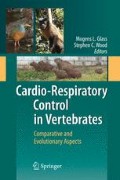Abstract
The oxygen transport system in the human body is described from atmospheric air to working skeletal muscles. It is illustrated that the pulmonary diffusion capacity becomes critical during whole body exercise as the arterial oxygen tension decreases markedly. Furthermore, the Bohr effect on the oxyhaemoglobin dissociation curve means that, with a lowering of pH to below 7.0, arterial oxygen saturation may decrease to below 90%. In addition, the ability to increase cardiac output limits the oxygen transport capacity when working with several muscle groups at the same time, and muscle blood flow is reduced by approximately 30% compared with times when only a single muscle group is activated. Oxygen diffusion to the myocytes thereby becomes affected, while endurance training enhances blood volume and the number of capillaries surrounding the muscle cells as well as the size of the heart, and thus increases maximal oxygen uptake by approximately 50%.
Access this chapter
Tax calculation will be finalised at checkout
Purchases are for personal use only
References
American College of Sports Medicine (1998b) Exercise and physical activity for older adults. Med Sci Sports Exercise 30:992–1008
Blair SN, Brodney S (1999) Effects of physical inactivity and obesity on morbidity and mortality: current evidence and research issues. Med Sci Sports Exercise 31:S646–S662
Dalsgaard MK (2006) Fuelling cerebral activity in exercising man. J Cereb Blood Flow Metab 26:731–750
Drinkwater BL (1994) Physical activity, fitness and osteoporosis. In: Bouchard C, Shephard RJ, Stephens T (eds) Physical Activity, Fitness, and Health, International Proceedings and Consensus Statement. Human Kinetics Publishers, Champaign IL, pp. 724–736
Fritsch W (2000) Rowing in daily life. In: Fritsch W (ed) Rowing. Meyer & Meyer Sport Ltd, Oxford, pp. 148–183
Ide K, Secher NH (2000) Cerebral blood flow and metabolism during exercise. Prog Neurobiol 61:397–414
Mosso A (1904) Fatigue. Swan Sonnenschein, London
Nybo L, Secher NH (2004) Cerebral perturbations provoked by prolonged exercise. Prog Neurobiol 72:223–261
Secher NH (1983) The physiology of rowing. J Sports Sci 1:23–53
Secher NH, Volianitis S (2006) Are the arms and legs in competition for cardiac output? Med Sci Sports Exercise 38:1797–1803
Volianitis S, McConnell AK, Koutedakis Y, McNaughton L, Backx K, Jones DA (2001) Inspiratory muscle training improves rowing performance. Med Sci Sports Exercise 33:803–809
Wagner PD, Hoppler H, Saltin B (1977) Determinants of maximal oxygen uptake. In: Crystal RG, West JB (eds) The Lung. Lippincott-Raven, Philadelphia, pp 2033–2041
Yoshiga CC, Higuchi M (2003b) Rowing performance of female and male rowers. Scand J Med Sci Sports 13:317–321
Further reading
Pedersen BK, Saltin B (2006) Evidence for prescribing exercise as therapy in chronic disease. Scand J Med Sci Sports 16(Suppl 1):3–63
Rankinen T, Bray MS, Hagberg JM, Pérusse L, Roth SM, Wolfarth B, Bouchard C (2006) The human gene map for performance and health-related fitness phenotypes: the 2005 update. Med Sci Sports Exercise 38:863–1888
Author information
Authors and Affiliations
Corresponding author
Editor information
Editors and Affiliations
Rights and permissions
Copyright information
© 2009 Springer-Verlag Berlin Heidelberg
About this chapter
Cite this chapter
Volianitis, S., Secher, N.H. (2009). Human Exercise Physiology. In: Glass, M., Wood, S. (eds) Cardio-Respiratory Control in Vertebrates. Springer, Berlin, Heidelberg. https://doi.org/10.1007/978-3-540-93985-6_20
Download citation
DOI: https://doi.org/10.1007/978-3-540-93985-6_20
Published:
Publisher Name: Springer, Berlin, Heidelberg
Print ISBN: 978-3-540-93984-9
Online ISBN: 978-3-540-93985-6
eBook Packages: Biomedical and Life SciencesBiomedical and Life Sciences (R0)

